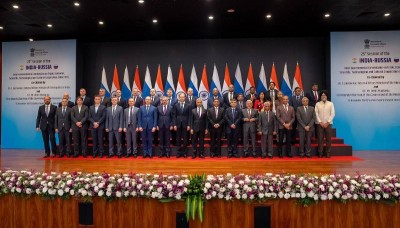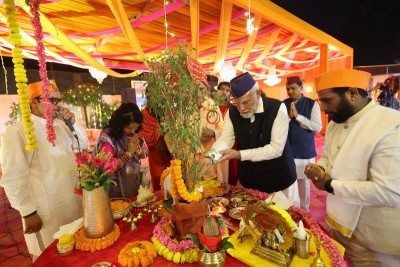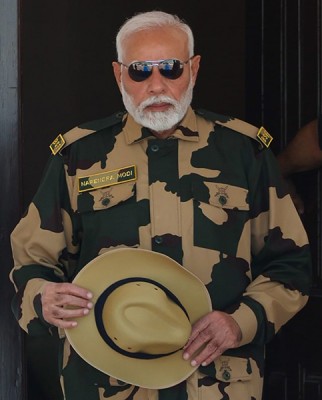
Nagaland: Evasive Reconciliation
As in 2013, there was no fatality among Security Forces (SFs) in 2014. In fact the last fatality in this category was recorded in 2008, when the Police on May 11, 2008, recovered the body of an Indian Reserve Battalion (IRB) trooper between the Keyive and Heningkunglwa areas under Peren District. Earlier, Nationalist Socialist Council of Nagaland-Isak-Muivah (NSCN-IM) cadres had killed an IRB trooper at Diphupar village in Dimapur town on April 25, 2008.
Fatalities were reported from five Districts in 2014 - Mon, Phek, Dimapur, Kiphire and Mokokchung - as against seven Districts in 2013. In 2013, these included Mon, Dimapur, Kiphire, in common with 2014, as well as Kohima, Tuensung, Zunheboto and Wokha.
Of the 11 civilians killed in 2014, nine died in a single incident. On January 3, 2014, the highly decomposed bodies of nine Karbi tribesmen, who were blindfolded with their hands tied and shot from close range, were found in a gorge in Dimapur District. The Rengma Naga Hills Protection Force (RNHPF), a group supported by the NSCN-IM, claimed responsibility for the killings. The incident was linked to Karbi People's Liberation Tiger (KPLT) militants' killing of a Rengma Naga tribesman in the Karbi Anglong District of Assam on December 27, 2013.
Two other civilians were killed in two separate incidents - at Mukalimi village in Zunheboto District on January 23 and at Phek Town in Phek District on June 3.
By comparison, the 11 civilian fatalities in 2013 were recorded in nine separate incidents
Fatalities among militants witnessed a steep decline, with just four killed in 2014. Of these, two were killed in two separate fratricidal clashes among Naga militant formations - a cadre each of NSCN-Khole-Kitovi (NSCN-KK) and Federal Government of Nagaland (FGN). On November 5, 2014, SFs killed a United Liberation Front of Asom-Independent (ULFA-I) cadre, identified as Ananta Duttaalias Prakash Baruah, in an encounter at Charing Basti in Mokokchung District. Another ULFA-I cadre, identified as 'assistant finance secretary and operational commander' Partha Asom alias Partha Pratim Gogoi, was reportedly killed on January 15, 2014, by cadres of his own group under the order of ULFA-I chief Paresh Baruah, who feared that Gogoi was about to surrender to the SFs on January 26, 2014.
The number of militants killed in 2013 stood at 21. More importantly, 12 of these militants were killed and another 11 were injured in 18 fratricidal clashes. The worst of these took place on December 2, 2014, when three NSCN-Khaplang (NSCN-K) cadres were killed while one was injured in a factional clash with NSCN-KK cadres at Sikiu under Shamator sub-division in Tuensang District. Another two were killed by SFs in two separate incidents - one each of NSCN-IM and NSCN-K.
Clearly, a marked improvement has been witnessed through 2014 in terms of fratricidal clashes as well, which had undermined the State's security environment for several years. According to SATP data, a total of 426 militants have been killed in such clashes since 2001, the highest number in 2008, when a total of 101 militants were killed in internecine fighting. The worst of recorded incident took place on June 4, 2008, when at least 15 cadres of the NSCN-IM and the Unification faction of NSCN (NSCN-U) were killed in separate factional clashes in and around Dimapur.
Fratricidal clashes among Naga groups outside Nagaland, and resultant casualties, also registered a decline in 2014 as compared to the preceding year. Five such incidents, resulting in three deaths and two injuries, were reported in 2014; as against seven such incidents in 2013, resulting in nine deaths and two injuries.
The improvement is primarily due to the signing of the 'Lenten Agreement' on March 28, 2014, during a two-day reconciliation meeting of three Naga militant groups - NSCN-IM, NSCN-KK and Naga National Council/ Federal Government of Nagaland (NNC/FGN) - at Dimapur, under the banner of the Forum for Naga Reconciliation (FNR). The agreement, signed by six top leaders of the three groups, stated that, in accordance with the Naga Concordant signed on August 26, 2011, they agreed "in principle to form the NNG [Naga National Government]". This development led to a sharp decline in fratricidal clashes. The joint statement, following the agreement, stated, "While this task is being carried out, we call for maintenance of the status quo, by vigilantly refraining from any unwarranted activities by the Nagas".
Since an overwhelming proportion of violence in the State had been the result of turf wars between the Naga factions, various other parameters of violence, including explosions and abductions also declined. However, six incidents of explosion, resulting in injuries to five persons, were reported in 2014; as against eight such incidents, resulting in two civilian deaths, recorded in 2013.
The SATP database recorded six incidents of abduction [in which eight people were abducted] in 2014, whereas 12 persons were abducted in 10 such incidents in 2013. 10 incidents of extortion were also recorded in 2014, as against nine incidents reported in 2013. The numbers relating to both abduction and extortion are gross underestimates as most such incidents go unreported, as victims comply without reporting to the Police.
165 militants were arrested in 95 incidents during 2014. These included 56 militants of NSCN-IM, 35 NSCN-K, 33 of NSCN-KK, 24 belonging to different Naga National Council (NNC) factions, nine belonging to the Assam-based United People's Liberation Army (UPLA), and five belonging to the Assam-based IK Songbijit faction of the National Democratic Front of Bodoland (NDFB-IKS). 146 militants were arrested in 69 incidents in 2013.
Despite these positive developments, areas of concern persist. Border clashes along State boundaries remain a challenge. Indeed, in one of the worst clashesalong the Nagaland-Assam border, which erupted on August 12, 2014, at least 20 people were killed in the Golaghat District of Assam. Clashes along the interstate borders of these two States, over the years, have claimed many lives. The worst of such clashes took place in 1979 when at least 54 people were killed. Signficantly, a three-judge bench of the Supreme Court (SC) headed by Justice T.S. Thakur, on January 14, 2015, observed that the boundary dispute between Assam and Nagaland could be resolved either by deciding the 1988 law suit filed by Assam or by referring the matter for arbitration. On the issue as to which State will have control over the disputed area for maintaining law and order and administrative purposes, the bench observed, "it is for the political executive to decide and it cannot be managed by the judiciary."
It is the prevailing and frequent diktats of the Naga militant formations that remain the primary public and security concern. For instance, the 'civilian arm' of NSCN-IM, the 'Government of the People's Republic of Nagalim' (GPRN), through its 'ministry of mines and minerals' on July 9, 2014, wrote to Metropolitan Oil and Gas Pvt. Ltd. (MOGPL), rejecting the firm's prospecting licence, leading to cessation of work. MOGPL, however, launched the pre-production phase of its operation at Old Jalukie village in Peren District in September. Kireshwar Bora, Chief Operating Officer stated, on September 23, 2014, that drilling operations had started in Changpang field (Wokha District). The permit was issued by the State Government of Nagaland in February 2014 to develop the Wokha and Peren oil zones.
In another development highlighting this crisis, the Angami Youth Organization (AYO) and Chakhesang Youth Front (CYF), on April 29, 2014, banned NSCN-K cadres from entering Angami tribal areas, and cautioned all Government establishments, institutions, contractors, corporate, public and private individual business owners against contributing any form of "tax and percentages" to the group. This came after a member of the Action Committee against Unabated Taxation (ACAUT), Abe Mero, was attacked by a suspected NSCN-K militant on April 9, 2014 in Kohima.
Significantly, according to a May 27, 2014, report, Joel Nillo Kath, the 'co-chairman ' of ACAUT, noted that multiple 'taxation' and illegal collection started right from the entry gates to the State, where different militants and 'government agencies' charge exorbitant rates in the form of yearly tax on vehicle, transport, and goods entry on every item, including essential commodities. He added that militant groups started the system of 'dealership' for almost all commodities, as a result of which only a small coterie of businessmen were allowed to deal in those commodities.
ACAUT was formed by several organizations under the aegis of the Naga Council in May 2013, in an effort to check the rampant imposition of 'illegal tax' on the people, especially the business community, by various organizations, particularly including Naga militant outfits.
It is, consequently, useful to assess the losses and gains as a result of the cease-fire agreements signed between the Naga groups and the Central Government, and the several rounds of talks that have followed. R. N. Ravi, the current chairman of the Joint Intelligence Committee (JIC), who was appointed by Central Government as the interlocutor for talks with Naga groups on August 9, 2014, in a news article published on January 23, 2014, observed:
The reckless 'ceasefire' between the Government of India and the National Socialist Council of Nagalim (NSCN-IM). for the last 17 years is pushing the Nagas into a state of civil war. While the protagonists of the 'ceasefire,' New Delhi and the NSCN (I-M), are in mutual comfort capering about the mulberry bush without a stopwatch, the process has landed the Nagas in an orbit of self-destruction. They are far more fragmented and fractious than before... Over 1,800 Nagas have been killed in some 3,000 fratricidal clashes since the beginning of the 'ceasefire' (1997-2013). Contrast it with the violence during the 17 years preceding the 'ceasefire' (1980-96) that took a toll of some 940 Naga lives in 1,125 clashes mostly with the security forces. The crucial stakeholders - the popularly elected State government, the traditional Naga bodies that wield wide and deep influence on their respective tribes and other active militias in the fray - were excluded from the process. . NSCN (I-M), notwithstanding its pan-Naga pretensions, is essentially a militia of the Tangkhul tribe of Manipur with little resonance with the broad Naga family. A deal cut with it would not be acceptable to the Naga society. The 'ceasefire' with the NSCN-IM has resulted in the retreat of the state from the crucial areas of governance and subversion of democratic politics. The absence of a credible state has created a power vacuum that is being filled in by chaotic sub-nationalist forces often at war with one another.
More than 70 rounds of talks have taken place between NSCN-IM and the Central Government since 1997, without any concrete gains, other than the fact that the outfit has reportedly given up its demand for 'sovereignty'. Likewise, the cease-fire agreements signed with other prominent Naga insurgent groups - NSCN-K [signed in 2001] and NSCN-KK [signed in 2012] - have also failed to construct any substantive solution to the lingering conflict.
For long, a policy of drift appeared to dominate the approach to militancy in Nagaland and its overflow into neighbouring States. The new dispensation in New Delhi has, however, articulated a time bound strategy of negotiations with Naga groups. On October 18, 2014, while commenting on peace talks with NSCN-IM, National Security Adviser Ajit Doval noted, "There should never be any feeling that it (talks) is protracted. The (peace) process is the means to an end and if there is an end, which is a desired end, it must be found in real time. There should be rule of law in the Naga insurgency-affected areas for which peace process must be completed as early as possible." It remains to be seen how these declarations are translated into policy and process.
Support Our Journalism
We cannot do without you.. your contribution supports unbiased journalism
IBNS is not driven by any ism- not wokeism, not racism, not skewed secularism, not hyper right-wing or left liberal ideals, nor by any hardline religious beliefs or hyper nationalism. We want to serve you good old objective news, as they are. We do not judge or preach. We let people decide for themselves. We only try to present factual and well-sourced news.







